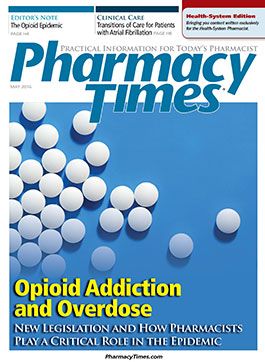Publication
Article
Pharmacy Practice in Focus: Health Systems
Case Report: Congestive Heart Failure
Author(s):
The patient's heart failure needs to be classified to determine the appropriate treatment strategy.
Case Presentation
WC is a 67-year-old man with hypertension, hyperlipidemia, and coronary artery disease, and had triple bypass surgery 17 years ago. His current home medications include amlodipine 10 mg once daily, atorvastatin 80 mg once daily, and aspirin 81 mg once daily. He presents to the clinic with shortness of breath (SOB), which occurs when performing simple tasks such as sweeping the floor. He reports sleeping in a recliner at night due to orthopnea. Physical examination reveals elevated jugular venous pressure and 1+ pitting lower extremity edema (LEE). An echocardiogram demonstrates systolic dysfunction, mild mitral regurgitation, a dilated left atrium, and an ejection fraction (EF) of 30%. Laboratory results show a pro-B-type natriuretic peptide level of 1302 pg/mL, a troponin level of <0.34, and an unremarkable basic metabolic panel (BMP). Measurement of vital signs shows blood pressure (BP) of 156/92 mm Hg, a heart rate of 80 beats/min, an Spo2 of 94%, a temperature of 36.5 °C, a pain level of 2 on a scale of 10, and a weight of 185 lb (84.1 kg). WC’s pharmacy coverage is Medicare Part D. The medical team would like assistance in optimizing the medication regimen for WC’s new diagnosis.
Discussion
First, the patient’s heart failure needs to be classified to determine the appropriate treatment strategy. The patient’s EF is ≤40%; therefore, per the American College of Cardiology Foundation/American Heart Association (ACCF/AHA) 2013 Guideline for the Management of Heart Failure, WC’s condition will be categorized as heart failure with reduced ejection fraction (HFrEF), also known as systolic heart failure.1 The atrial dilation and systolic dysfunction seen on the echocardiogram are evidence of structural heart disease. The patient is also exhibiting symptoms that limit his daily activities. These 2 findings together categorize the patient’s condition as ACCF/AHA stage C.1 Further, the patient has SOB with normal activity, but is comfortable at rest, so his condition has a functional classification of II, according to the New York Heart Association (NYHA) .1
The following are indicated for stage C HFrEF: an angiotensin-converting enzyme (ACE) inhibitor (or angiotensin receptor blocker if the patient cannot tolerate an ACE inhibitor) and beta blocker (specifically metoprolol succinate, bisoprolol, or carvedilol).1 In addition, for NYHA functional classes II through IV, an aldosterone antagonist is recommended if the estimated creatinine clearance is >30 mL/min and the potassium level is <5.0 mEq/dL.1 In clinical trials, these medication classes have demonstrated a decrease in mortality and morbidity when used in patients with HFrEF.2-4 Non-dihydropyridine channel blockers, such as verapamil and diltiazem, are not recommended due to their negative inotropic effects, which may cause harm in patients with HFrEF.1 Despite a lack of mortality benefit, loop or thiazide diuretics are recommended for symptomatic management of hypervolemia in patients with normal renal function.5 A diuretic is also recommended with initiation of a beta blocker in hypervolemic patients, due to increased fluid retention caused by beta blockers. It is important not to delay initiation of a beta blocker in these patients, due to the significant benefit demonstrated in clinical trials.1
Because amlodipine is an antihypertensive that may contribute to LEE and has no proven functional or mortality benefit in HFrEF, it is reasonable to discontinue this medication in this patient. Hypertension is an important modifiable risk factor for all classifications of heart failure.1,6,7 Per the 2014 American Society of Hypertension and the International Society of Hypertension (ASH/ISH) guidelines for the management of hypertension, WC’s goal BP is <140/90 mm Hg.7 It would be acceptable to restart this medication at a later date if target doses of the ACE inhibitor, beta blocker, and aldosterone antagonist do not achieve the patient’s BP goal.
Based on guideline recommendations and evidence-based medicine, the following are reasonable recommendations for WC: discontinue amlodipine; initiate lisinopril 5 mg once daily, titrating it to the BP goal or a target dose of 40 mg, as tolerated; initiate furosemide 20 mg once daily, titrating it to the patient’s goal dry weight; initiate metoprolol succinate 25 mg once daily, titrating it, as tolerated, to a target dose of 200 mg once daily over 8 weeks; initiate spironolactone 25 mg once daily; return to the clinic in 3 to 7 days to reassess volume status, BP, and BMP to monitor renal function and electrolytes.
Heather Steelman Coleman, PharmD, is a PGY1 Ambulatory Care Pharmacy Resident at University of North Carolina (UNC) Health Care. She earned her doctor of pharmacy degree from UNC Eshelman School of Pharmacy.
References
- Writing Committee Members, Yancy CW, Jessup M, Bozkut B, et al. 2013 ACCF/AHA guideline for the management of heart failure: a report of the American College of Cardiology Foundation/American Heart Association Task Force on practice guidelines. Circulation. 2013;128(16):e240-e327. doi: 10.1161/CIR.0b013e31829e8776.
- Garg R, Yusuf S. Overview of randomized trials of angiotensin-converting enzyme inhibitors on mortality and morbidity in patients with heart failure: Collaborative Group on ACE Inhibitor Trials. JAMA.1995;273(18):1450-1456.
- Effect of metoprolol CR/XL in chronic heart failure: Metoprolol CR/XL Randomised Intervention Trial in Congestive Heart Failure (MERIT-HF). Lancet. 1999;353(9169):2001-2007.
- Pitt B, Zannad F, Remme WJ, et al; Randomized Aldactone Evaluation Study Investigators. The effect of spironolactone on morbidity and mortality in patients with severe heart failure. N Engl J Med. 1999;341(10):709-717.
- Leto L, Aspromonte N, Feola M. Efficacy and safety of loop diuretic therapy in acute decompensated heart failure: a clinical review. Heart Fail Rev. 2014;19(2):237-246. doi: 10.1007/s10741-012-9354-7.
- James PA, Oparil S, Carter BL, et al. 2014 evidence-based guideline for the management of high blood pressure in adults: report from the panel members appointed to the Eighth Joint National Committee (JNC 8). JAMA. 2014;311(5):507-520. doi: 10.1001/jama.2013.284427.
- Weber MA, Schiffrin EL, White WB, et al. Clinical practice guidelines for the management of hypertension in the community: a statement by the American Society of Hypertension and the International Society of Hypertension. J Hypertens. 2014;32(1):3-15. doi: 10.1097/HJH.0000000000000065.







